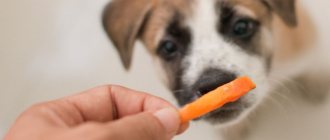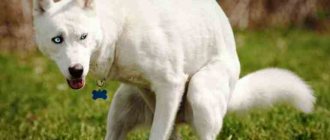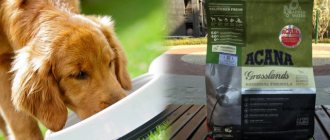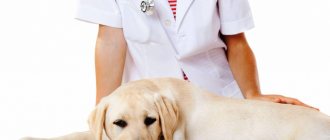The idea of natural nutrition is becoming increasingly popular among dog breeders. This raises the question: can dogs have boiled and raw potatoes? After all, this vegetable is most often found in the owners’ homes, and it’s quite simple to cook it, if necessary.
Potato pulp is based on starch. In large quantities, it can harm the animal: not only does it not provide enough clean energy for exercise and life in general, but it can also provoke weight gain or exacerbation of chronic diseases. Feeding both including and excluding potatoes must be approached consciously.
Can dogs be given potatoes?
Canines digest food much faster than humans. This means that excessive consumption of “fast carbohydrates” harms them more. Can dogs have boiled potatoes or raw potatoes, given this feature of theirs? Yes, but you need to try whether such food is suitable for a particular pet, compare its pros and cons.
The benefits of potatoes for dogs
Potatoes are highly valued due to their chemical composition. It contains vitamins B, E, C, as well as calcium, magnesium, phosphorus, iodine. Potatoes also contain potassium. It has a good effect on the functioning of the myocardium and circulatory system, which is why potatoes are often included in food for dogs with cardiovascular pathologies. But can dogs have raw potatoes? Yes. In addition to the described vitamins, it has a useful property - it removes toxins from the body and promotes the development of intestinal microflora. The main thing here is not to overfeed the dog, otherwise the effect will disappear.
Harm
Natural food lovers often ask the question: “Why can’t dogs have potatoes?”, if they are a common root vegetable that a number of canines could even eat in their natural environment. This is true, but the body of a modern domestic dog is not always ready for starch and corned beef. Side effects from eating potatoes include:
- Digestive system disorders: diarrhea, nausea, vomiting.
- Poisoning due to a large amount of oil if the potatoes are fried.
- Rapid weight gain and disruptions in the hormonal system.
- Shortness of breath and convulsions due to solanine poisoning.
- Violation of the level of acidity in the stomach and intestines with prolonged and excessive use.
How to cook noodles for your pet
Many breeders are not satisfied with the store-bought product. Therefore, they prefer to make and cook pasta themselves. Fortunately, this is not difficult to do. The composition is very simple:
- egg;
- water;
- flour.
The egg is beaten and mixed with a few tablespoons of water. After this, flour is poured in and the whole mass is thoroughly mixed. The consistency of the dough should be dense but pliable. Now a sheet is rolled out and left on the table for a couple of hours to dry. Then it is folded into a roll and cut into strips. It is additionally dried in the oven at a temperature of 50-70 degrees.
On a note! When making homemade noodles, it is better to use durum wheat flour - it contains more fiber and less carbohydrates.
The dried product can be stored for a long time in a jar or other sealed container. It can be boiled and given to your pet at any time along with chicken, minced meat or lean meat. And you can cook your own dog pasta, for example, with stew - it will turn out very tasty.
How much and how often to give pasta to pets
Dogs eat spaghetti and any other pasta with pleasure. But they should not be given too often, a maximum of a couple of times a week. Only for animals that live outside, on cold winter days you can increase the number of feedings to 3-4 times a week. The rest of the time, you should replace pasta with cereals - buckwheat, oatmeal, rice or millet are suitable. The main thing is not to feed potatoes or pearl barley, this can lead to serious health problems.
Homemade noodles are a great alternative
Also, when feeding, it is worth remembering that pasta should not account for more than 20-25% of the diet. The rest is meat or offal, as well as vegetables.
In what form can you give potatoes to dogs?
Can dogs eat potatoes? Yes, and potatoes suit them in almost any form. But it is important that it is not fried, since poisoning from sunflower or other vegetable oil that has soaked it can cause health problems. You also need to make sure that the vegetable is fresh. Therefore, there is no need to give your pet overripe or green potatoes. Such vegetables will negatively affect the digestion of your pet or may even lead to its poisoning and death. This is especially likely if the animal accidentally eats potato seeds.
Useful properties of pasta
In Italy, only those made from durum wheat are considered pasta. In Russia there is no such rule. All pasta is made according to GOST. Hard varieties belong to group A, soft varieties belong to group B.
Group A pasta contains many useful substances:
- Fiber for the cardiovascular system.
- B vitamins.
- High carbohydrate content.
- Rapidly broken down fat.
- Starch in the form of crystals.
All this is beneficial for the human body. What about canine? Can dogs have pasta? Or is it not worth risking your pet's health?
In small quantities, fiber is beneficial for four-legged animals, as it helps normalize stool.
B vitamins are especially useful for pregnant females.
How to properly feed your dog this product?
First you need to choose the form of heat treatment for the potatoes that you are going to give to your dog. It is, of course, advisable not to feed your dog boiled potatoes at all, since during the cooking process they release potentially dangerous toxins. But, if you do everything correctly and do not base your pet’s diet on vegetables, there will be no problems. Potatoes are:
- Raw. You can give your dog raw potatoes as long as they are completely ripe and fresh. When choosing the ideal vegetable for your pet, carefully inspect the skin of the tuber. There should be no green spots on it, signaling corned beef, as well as sprouts, young roots, indicating that the tuber is stale.
- Boiled in its jacket. Such potatoes are considered the most useful for both pets and humans. It retains the maximum amount of useful substances and vitamins, but removes harmful substances along with water. This reduces the risk of poisoning the dog.
- Baked potato. It is suitable even for individuals with sensitive digestion, as it simply contains the entire set of vitamins and microelements described earlier. Cool the vegetable before giving it to the animal, otherwise it will not be beneficial.
- Mashed potatoes. It will be useful for your pet if you mix it with other vegetables, as well as with some meat by-products or real fillet. Additional components will compensate for the abundance of starch and make the food also attractive to the pet itself.
As for the amount of potatoes consumed, you can offer your pet up to two tubers per week. Moreover, at one time you can cut him into a bowl or give him whole up to half of one average potato. Vegetables should make up up to 10% of a pet's diet. Potatoes should account for up to 4%. Don't be overzealous with introducing vegetables and fruits into his diet, but don't ignore them either. Then the pet’s body will receive the necessary substances and, accordingly, maintain its original health.
In what form to give
Experts believe that raw potatoes are the healthiest for dogs. It retains all the nutrients that lose their properties during heat treatment. There are animals that happily gnaw on pieces of potato, and there is no need to panic about this. Vice versa! Such a product will be more beneficial than a spoonful of mashed potatoes with milk and butter (although the pet will not refuse the latter dish).
Important!
Fried potatoes for pets are strictly prohibited. And the danger is not so much the root vegetable itself as the oil in which it is fried, since it contains carcinogens.
If your dog refuses to eat raw potatoes, you can chop them up and mix them with vegetables or minced meat. But you can offer your pet baked potatoes or boiled potatoes in their jackets. The main part of the beneficial substances is located under the peel, and this type of processing allows you to preserve them in maximum quantities. However, the tubers should be cleaned and cooled before feeding.
Important!
Only healthy tubers are suitable for feeding. If they have green spots, there is a risk of solanine poisoning. This is a toxic substance that irritates the mucous membranes of the gastrointestinal tract, causes vomiting and inflammation. In case of poisoning, the following are affected:
- kidneys, which can lead to severe nephritis and damage to the central nervous system;
- respiratory organs (respiratory rate decreases, shortness of breath appears);
- heart and vascular system.
Poisoning is usually acute, and the danger to the animal is posed not only by the green potatoes, but also by the water in which they were boiled. Therefore, in order not to endanger your pet, you should carefully select tubers.
In what cases are potatoes contraindicated?
Even fresh root vegetables should not be given to puppies under one year of age. Their body is simply not ready to digest so much starch. And the small animal should receive all the vitamins contained in the vegetable by consuming meat. It is worth introducing vegetables into his diet only in the sixth month and you should not start with potatoes. The same rules apply to dogs with stomach or intestinal problems. Potatoes are beneficial for pregnant or lactating dogs. It provides their bodies with accessible energy in cases where strength is in short supply.
Breeders may also have the following question: “Why does a dog eat raw potatoes if they seem to harm him?” This could signal either a lack of unprocessed fresh vegetables in her daily diet or simple food curiosity. Dogs do not understand what is good for their digestive system and what poses a serious danger. They can eat anything that has an attractive smell and appearance. Because of this, their health is a person's responsibility.
How to help a dog if it is poisoned by potatoes?
Potatoes are poorly digestible in dogs. Therefore, situations where a dog has diarrhea from boiled potatoes, weight gain from eating boiled potatoes, or other side effects are often described on breeder forums. Actions in case of pet intoxication with potatoes should be as follows:
- Give him activated charcoal or an absorbent, put the tablet on the root of his tongue and force him to swallow.
- If possible, give your pet an enema before taking the medicine to quickly remove toxic substances.
- If the tablet is not available, induce vomiting by pressing on your pet's tongue with your fingers, but do not do this if there are seizures.
The first signs of potato poisoning appear within three hours in puppies and up to six hours in mature animals. It can be identified by the following signals: difficulty breathing, refusal to eat, poor coordination, apathy, cough. In the worst case scenario, a dog who does not like raw or boiled potatoes may fall into a coma.
Self-medication for signs of a serious problem is prohibited. Call the veterinarian immediately or take the animal to the clinic yourself. For rehabilitation, the pet will need an IV, and only a professional veterinarian can install it. But in order for him to choose the right treatment strategy, tell him about your suspicions of potato poisoning. Most likely, it will be the cause of an unfavorable condition. Fresh or unripe tubers, mashed potatoes, and boiled pieces of vegetables can lead to such consequences.
What can feeding pasta lead to?
You can add floury products to cereals or meat foods, but excessive intake of pasta into a dog’s body can lead to the development of obesity, diabetes, and pancreatitis. Indigestion, bloating, gas formation - these are the very first “bells” indicating that you need to be more attentive to your pet’s health and urgently review its diet.
It is believed that a dog’s menu should consist of 70% meat and other animal foods, and 30% plant foods, but this also includes vegetables and fruits, which contain much more vitamins and minerals and other nutrients than “empty” pasta.











